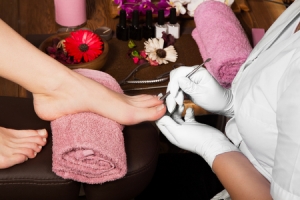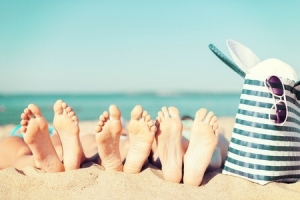Connect With Us
Blogs
Displaying items by tag: ingrown toenails
Show Some Gratitude for Your Feet
It’s the season of Thanksgiving and here at Superior Foot & Ankle Care Center we think your feet deserve to be on the list of things that you’re thankful for! The 26 bones, 33 joints, 107 ligaments and 19 muscles in each of your feet work together in complex and amazing ways to enable you to do all the activities you enjoy. Why not show your feet some gratitude with one or more of these proactive podiatric health ideas:
Pay attention: Many times your feet are the starting place of diseases that affect your entire body such as diabetes, arthritis, circulatory and nerve problems. Get in the habit of inspecting your feet regularly and report any unusual changes to the foot doctor. Even more minor problems—ingrown toenails, warts, athlete’s foot—are more easily treated when caught in their earliest stages.
Do a shoe review: Are your shoes hurting your feet? Check to see that the shoes you wear have adequate arch and ankle support as well as cushioning for the sole. This will go a long way to preventing foot injuries and chronic conditions. Look for signs of wear and don’t continue to use shoes that are stretched out or have tears or loose stitching.
Have a spa day: pamper your feet with a relaxing foot soak. Then carefully trim toenails (straight across and not too short to avoid ingrown nails). Finish with a rich moisturizer massaged into your feet. If you prefer a salon pedicure just be sure to choose a place that follows proper sanitizing procedures for foot baths and tools to prevent fungal infections.
Watch your weight: being overweight puts excess strain and pressure on your feet and is a contributing factor in many foot problems. Maintaining a healthy weight will help reduce foot pain.
Get a checkup: When’s the last time you were in to our Long Beach office? Make an appointment by calling 562-420-9800 and let our podiatrists, Dr. Victoria Foley and Dr. Constance Omelas examine your feet. The foot doctor can alert you to any potential problems and make recommendations for ways that you can help keep your feet healthy.
What to Bring on Summer Vacation—for Your Feet
If you’re packing for a summer trip, your feet may not be the first thing on your mind, but at Superior Foot & Ankle Care Center we want to remind patients that if your feet are hurting on vacation, you won’t enjoy yourself. The good news is your feet won’t need their own bag, just a few small items that can have a big impact on comfort, health and safety of your feet. Here’s what to bring:
- Moleskin—it’s a good idea not to bring brand new shoes that you haven’t worn before on a vacation. Chances are you’ll be doing more walking than usual and when you’re away from your closet is not the ideal time to discover that the shoes you brought are uncomfortable. Sometimes, however, even previously comfortable shoes can start to rub if it’s especially hot and your feet are sweaty from the increased activity. Moleskin can save the day. Put a small piece on the part of your foot that is feeling irritated and it will hopefully help you get through the day without a blister. Of course, you should still change your shoes as soon as possible.
- Sunscreen—this is probably already in your travel bag, but make sure you remember to apply it to the tops and bottoms of your feet as frequently as you apply to the rest of your body. Don’t forget to reapply after swimming.
- Emery board and nail clippers—a rough nail can become torn and painful. Keep an emery board with you for filing and bring along your nail clippers too. Remember to clip toenails straight across to help prevent ingrown nails from forming.
- Extra socks—if your feet tend to sweat excessively or you know you’ll be in a warm place where you’ll be doing activities like hiking or sightseeing, change your socks as soon as you feel that your feet are damp. This will help prevent a case of athlete’s foot from becoming your vacation souvenir. Fungal and bacterial infections thrive in dark, damp places.
- Flip flops—use these around the pool or at the beach to prevent feet from coming in contact with fungi in public places. Don’t wear these as your everyday shoes however, or you risk injury and other painful foot conditions such as plantar fasciitis and flat feet.
If you do injure your foot while you are away be sure to seek treatment promptly and follow up by contacting our Long Beach, CA office for an appointment when you return. Our podiatrists, Dr. Victoria Foley and Dr. Constance Ornelas will want to check your foot and be sure that it is healing properly.
Summer Checklist for Preventing Children’s Foot Problems
Chances are with the end of the school year your child came home with readings lists and other summer work. At Superior Foot & Ankle Care Center we’d like to add one more list: a checklist for taking care of your child’s feet over the summer months. Summer brings a whole new set of activities and options for children, many of which can lead to foot trouble if the proper precautions are not taken. Here are our top tips for keeping children’s feet healthy this season:
Slather on the Sunscreen—many people forget to apply sunscreen to their feet. The skin on your feet is just as susceptible to the harmful effects of UVB and UVA rays as that on the rest of your body. On beach and pool days you should put sunscreen on the tops and bottoms of your children’s feet and reapply after swimming. If your children are wearing sandals or other open shoes and will be out in the sun shopping or sightseeing you should also put sunscreen on their feet then.
Pack the Flip Flops—summertime is high season for athlete’s foot, fungal toenails and warts, all of which are spread by direct contact with the virus, fungi or bacteria that cause them. If you are spending time at a community pool or local beach make sure your child keeps their feet covered around the pool and in changing areas and bathrooms—these are prime hangouts for fungal infections. Encourage your children not to share shoes, socks, towels or any items that touch someone else’s feet.
Inspect Shoes—be sure that your child is wearing shoes that match the activity they are participating in. While flip flops are good for the pool, they can lead to injury if used for playing whiffle ball or other casual summer sports. Also keep an eye on fit—children’s feet grow fast and time spent squeezed into shoes that are too tight can increase the risk of ingrown toenails and fungal infections.
Keep it Clean—wash your children’s feet at the end of every day with a mild soap and warm water. Be sure to dry completely as well, especially between the toes. Trim toenails straight across with no curved edges. If your child’s feet sweat excessively, consider a foot powder to help keep them dry.
If when caring for your child’s feet you notice anything unusual or concerning, or if your child complains of foot pain, don’t hesitate to contact our podiatrists, Dr. Victoria Foley and Dr. Constance Omelas at our Long Beach office by calling 562-420-9800. It’s always better to get a foot concern checked than to wait and have it develop into a serious issue. Enjoy the summer and keep your children’s feet safe!
What’s Behind Ingrown Toenails?
Ingrown toenails (officially known as onychocryptosis), a condition we see frequently at Superior Foot & Ankle Center, are painful and potentially can lead to an infection. They occur when the side of a nail begins to grow back into the skin and are seen most often on the big toe. As the nail becomes ingrown the skin around it usually becomes inflamed, red, warm and very tender to the touch. Once the nail actually breaks through the skin, bacteria have an entry point and an infection may occur.
Causes
There are several factors that can make an ingrown nail more likely. Some are preventable but others are not. Common causes include:
- Poor nail trimming—this is the most common reason ingrown nails develop. If nails are shaped so that they curve on the sides or if they are trimmed too short, the skin may fold over the corner of the nail and the nail will begin to grow inward.
- Heredity—for some people ingrown nails are a genetic tendency.
- Shoes and socks that don’t fit—if you wear footwear that is too tight or spend a considerable amount of time in high heels that force all your toes together in the front of the shoe, the pressure may push the nail into the skin.
- Overuse or trauma—patients who run or play sports that involve frequent kicking are more likely to develop ingrown toenails. Dropping a heavy object on your toe or severely stubbing it can also be a catalyst.
- Nail problems—a fungal or bacterial infection or nail deformity can be a cause.
Treatment
If you have an ingrown toenail that soaking in warm water isn’t releasing, contact our Long Beach office by calling: (562) 420-9800 and let our podiatrists, Dr. Victoria Foley and Dr. Constance Omelas help you eliminate this painful condition. Don’t attempt “bathroom surgery” on an ingrown nail! Notching, sticking cotton under the nail and other “home remedies” not only are ineffective, but they can result in a more serious injury and infection.
Meeting the Needs of Seniors
At Superior Foot & Ankle Care Center, we know that our senior patients have special health care needs. Paying attention to and caring for your feet is essential to your overall health as many diseases such as diabetes, arthritis and certain nerve or circulation problems may first show symptoms in the feet. Maintaining mobility also means freedom to go where you wish and participate in the activities you love. Here are some ways that you can help protect the health of your feet if you are over 60:
- Take care of your eyes—wait, weren’t we just talking about feet? Yes, but many patients whose vision is failing have trip or fall accidents which result in sprained ankles or fractures in the foot. January is Glaucoma Awareness month. This disease currently affects more than 3 million Americans. Called “the sneak thief of sight,” vision loss from glaucoma can come on gradually and is irreversible. However, a simple eye exam can test for glaucoma (and other eye disorders) and treatment can prevent blindness. In fact glaucoma is the leading cause of preventable blindness.
- Wear shoes that fit properly without rubbing or squeezing any part of your foot. Choose shoes that have good arch and ankle support and a non-slip tread. Replace worn out shoes.
- Protect your circulation by walking frequently, avoiding sitting for long periods with your legs crossed and by not smoking.
- Keep toenails trimmed straight across and not too short to avoid ingrown nails.
- Inspect your feet daily (or if you are unable to do so ask someone to do for you). Look for bumps, bruises, swelling, changes in color, shape or skin discolorations or rashes. Report any changes to our podiatrists, Dr. Victoria Foley and Dr. Constance Omelas. Regular podiatric checkups are also an essential part of senior foot health. Most foot problems can be more easily treated and with less invasive measure if detected in their initial stages. If you have any foot concerns, contact our Long Beach office for an appointment today by calling: (562) 420-9800.
Good Shoes Make Holiday Shopping Easier
The holiday season has you on your feet more than usual: shopping at the mall, extra trips to the grocery store, parties after work, etc. At Superior Foot & Ankle Center we see an increase in many types of foot problems at this time of year just because people are on their feet so much more than usual. Do yourself a favor and make the first gift on your list be a well-made, properly fitting pair of shoes to do all your holiday errands in. Here are some shoe shopping tips:
- Choose flat shoes or ones with heels no higher than one inch
- Be sure soles have a good tread that will help you avoid falls on slippery sidewalks and parking lots
- Avoid shoes with narrow toe boxes that squeeze toes together; this can encourage ingrown toenails
- Look for breathable, natural materials that allow air to circulate to reduce the change of athlete’s foot and other fungal infections
- Run your hand all around the inside of the shoe to check for loose stitching or seams that can rub against the skin and cause irritation
- Shoe shop at the end of the day—that’s when feet are at their largest
- Make sure there is at least a half inch between the tip of your big toe and the end of the shoe
- If one of our podiatrists, Dr. Victoria Foley and Dr. Constance Omelas have prescribed special orthotic devices be sure to bring them to try on with your shoes
- Wear socks that are similar in thickness to the ones you will wear with your new shoes
- Try on both shoes and walk around for several minutes in the store. Shoes should be comfortable from the moment of purchase—don’t count on them feeling better after they are “broken in.”
- If you have any special foot needs—diabetic, hammertoes, bunions or other foot deformities or conditions, ask the foot doctor’s advice on the best shoes for you. You can always contact our Long Beach office with questions by calling (562) 420-9800.






